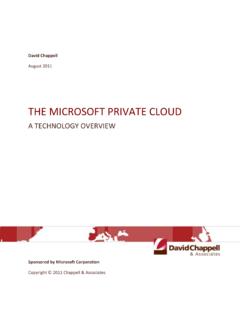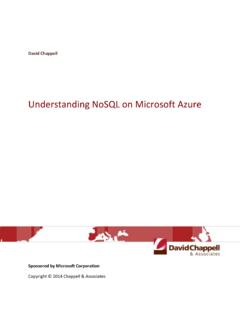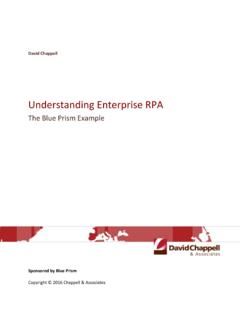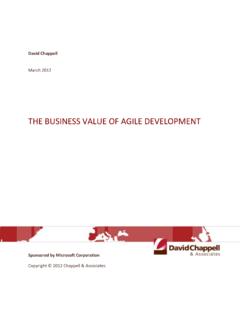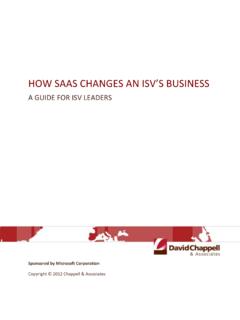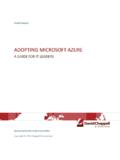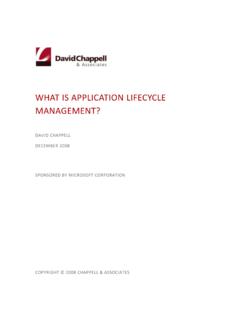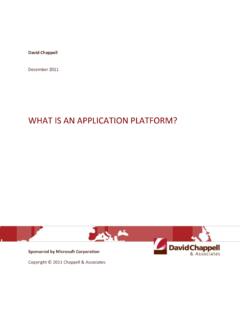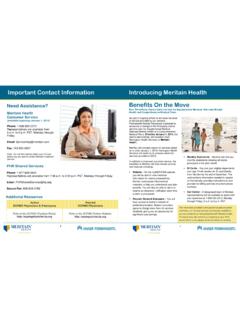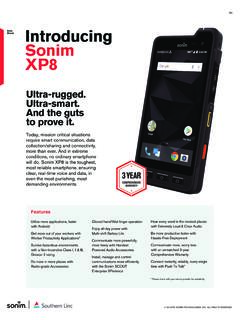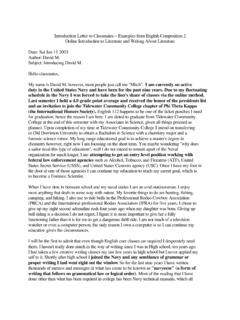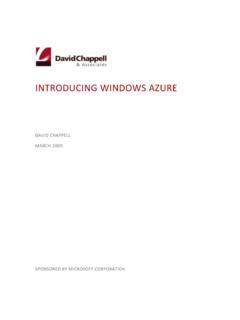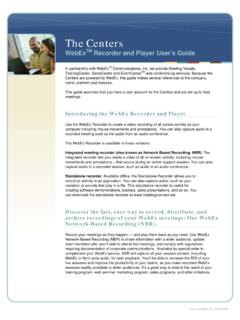Transcription of Introducing OData - David Chappell
1 David Chappell May 2011 Introducing OData DATA ACCESS FOR THE WEB, THE CLOUD, MOBILE DEVICES, AND MORE Sponsored by Microsoft Corporation Copyright 2011 Chappell & Associates 2 Contents Describing OData .. 3 The Problem: Accessing Diverse Data in a Common Way ..3 The Solution: What OData Provides ..3 How OData Works: Technology Basics ..5 Using OData : Example Scenarios .. 6 Accessing Application Data from Mobile Phones and Web Browsers ..6 Exposing Data from a Cloud Application ..8 Using Diverse Data Sources with Different BI Tools ..9 Examining OData : A Closer Look at the Technology and Its Implementation .. 10 The OData Data Model ..10 The OData Protocol ..12 Protocol Basics ..13 Serializing Data with Atom/AtomPub ..13 Serializing Data with JSON ..19 Issuing Queries ..20 A Perspective: OData in a SOA World ..21 OData Client Libraries ..22 OData Services ..22 Conclusion .. 23 For Further Reading.
2 24 About the Author .. 24 3 Describing OData Our world is awash in data. Vast amounts exist today, and more is created every year. Yet data has value only if it can be used, and it can be used only if it can be accessed by applications and the people who use them. Allowing this kind of broad access to data is the goal of the Open Data Protocol, commonly called just OData . This paper provides an introduction to OData , describing what it is and how it can be applied. The goal is to illustrate why OData is important and how your organization might use it. The Problem: Accessing Diverse Data in a Common Way There are many possible sources of data. Applications collect and maintain information in databases, organizations store data in the cloud, and many firms make a business out of selling data. And just as there are many data sources, there are many possible clients: Web browsers, apps on mobile devices, business intelligence (BI) tools, and more.
3 How can this varied set of clients access these diverse data sources? One solution is for every data source to define its own approach to exposing data. While this would work, it leads to some ugly problems. First, it requires every client to contain unique code for each data source it will access, a burden for the people who write those clients. Just as important, it requires the creators of each data source to specify and implement their own approach to getting at their data, making each one reinvent this wheel. And with custom solutions on both sides, there s no way to create an effective set of tools to make life easier for the people who build clients and data sources. Thinking about some typical problems illustrates why this approach isn t the best solution. Suppose a Web application wishes to expose its data to apps on mobile phones, for instance. Without some common way to do this, the Web application must implement its own idiosyncratic approach, forcing every client app developer that needs its data to support this.
4 Or think about the need to connect various BI tools with different data sources to answer business questions. If every data source exposes data in a different way, analyzing that data with various tools is hard an analyst can only hope that her favorite tool supports the data access mechanism she needs to get at a particular data source. Defining a common approach makes much more sense. All that s needed is agreement on a way to model data and a protocol for accessing that data the implementations can differ. And given the Web-oriented world we live in, it would make sense to build this technology with existing Web standards as much as possible. This is exactly the approach taken by OData . The Solution: What OData Provides OData defines an abstract data model and a protocol that let any client access information exposed by any data source. Figure 1 shows some of the most important examples of clients and data sources, illustrating where OData fits in the picture.
5 4 Figure 1: Any OData client can access data provided by any OData data source. As the figure illustrates, OData allows mixing and matching clients and data sources. Some of the most important examples of data sources that support OData today are: Custom applications: Rather than creating its own mechanism to expose data, an application can instead use OData . Facebook, Netflix, and eBay all expose some of their information via OData today, as do a number of custom enterprise applications. To make this easier to do, OData libraries are available that let .NET Framework and Java applications act as data sources. Cloud storage: OData is the built-in data access protocol for tables in Microsoft s Windows Azure, and it s supported for access to relational data in SQL Azure as well. Using available OData libraries, it s also possible to expose data from other cloud platforms, such as Amazon Web Services.
6 Content management software: For example, SharePoint 2010 and Webnodes both have built-in support for exposing information through OData . Windows Azure Marketplace DataMarket: This cloud-based service for discovering, purchasing, and accessing commercially available datasets lets applications access those datasets through OData . While it s possible to access an OData data source from an ordinary browser the protocol is based on HTTP client applications usually rely on a client library. As Figure 1 shows, the options supported today include: Web browsers: JavaScript code running inside any popular Web browser, such as Internet Explorer or Firefox, can access an OData data source. An OData client library is available for Silverlight applications as well, and other rich Internet applications can also act as OData clients. 5 Mobile phones. OData client libraries are available today for Android, iOS (the operating system used by iPhones and iPads), and Windows Phone 7.
7 Business intelligence tools: Microsoft Excel provides a data analysis tool called PowerPivot that has built-in support for OData . Other desktop BI tools also support OData today, such as Tableau Software s Tableau Desktop. Custom applications: Business logic running on servers can act as an OData client. Support is available today for code created using the .NET Framework, Java, PHP, and other technologies. The fundamental idea is that any OData client can access any OData data source. Rather than creating unique ways to expose and access data, data sources and their clients can instead rely on the single solution that OData provides. OData was originally created by Microsoft. Yet while several of the examples in Figure 1 use Microsoft technologies, OData isn t a Microsoft-only technology. In fact, Microsoft has included OData under its Open Specification Promise, guaranteeing the protocol s long-term availability for others.
8 While much of today s OData support is provided by Microsoft, it s more accurate to view OData as a general purpose data access technology that can be used with many languages and many platforms. How OData Works: Technology Basics Providing a way for all kinds of clients to access all kinds of data is clearly a good thing. But what s needed to make the idea work? Figure 2 shows the fundamental components of the OData technology family. Figure 2: An OData service exposes data via the OData data model, which clients access with an OData client library and the OData protocol. The OData technology has four main parts: 6 The OData data model, which provides a generic way to organize and describe data. OData uses the Entity Data Model (EDM), the same approach that s used by Microsoft s Entity Framework (EF)1. The OData protocol, which lets a client make requests to and get responses from an OData service.
9 At bottom, the OData protocol is a set of RESTful interactions it s just HTTP. Those interactions include the usual create/read/update/delete (CRUD) operations, along with an OData -defined query language. Data sent by an OData service can be represented on the wire today either in the XML-based format defined by Atom/AtomPub or in JavaScript Object Notation (JSON). OData client libraries, which make it easier to create software that accesses data via the OData protocol. Because OData relies on REST, using an OData -specific client library isn t strictly required. But most OData clients are applications, and so providing pre-built libraries for making OData requests and getting results makes life simpler for the developers who create those applications. An OData service, which exposes an endpoint that allows access to data. This service implements the OData protocol, and it also uses the abstractions of the OData data model to translate data between its underlying form, which might be relational tables, SharePoint lists, or something else, into the format sent to the client.
10 Given this basic grasp of the OData technology, it s possible to get a better sense of how it can be used. The best way to do this is to look at some representative OData scenarios. Using OData : Example Scenarios Because OData is a general-purpose data access mechanism, it can be used in many different ways. This section looks at three representative examples: Using OData to let mobile phones and Web browsers access a custom application s data. Letting application business logic use OData to access data exposed in the cloud. Allowing different BI tools to access diverse data sources through OData . Accessing Application Data from Mobile Phones and Web Browsers Users commonly access Web applications today through browsers. More and more, however, custom client applications are used in place of browsers, especially on mobile devices. And when those client apps need to access a Web application s functionality, using standard REST calls can work well.
